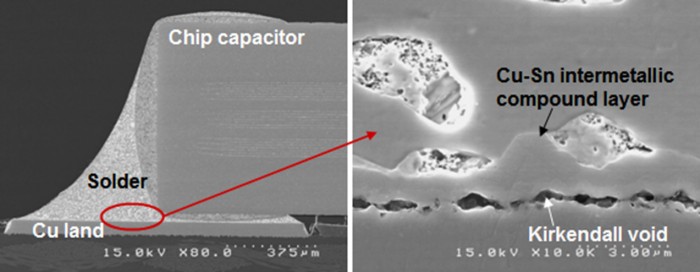Folks,
In my last post, I discussed intermetallic compounds (IMCs) and what I referred to as the “miracle of soldering.” I also mentioned that research focused on the brittle nature of IMCs suggests that failures in stress tests are more likely due to failures between the interfaces of the IMCs and the solder, the IMCs and the copper, or the IMCs (Cu6Sn5 with Cu3Sn) themselves and are not related to any perceived brittle nature of the IMCs.
Another weakening mechanism in soldering and thermal aging of solder joints is Kirkendall voids. Kirkendall voids form when one metal diffuses more rapidly into another metal than vice versa. A copper-tin interface displays such a mechanism. Copper diffuses into the tin more rapidly than the tin into the copper. This mechanism can result in actual voids in the copper at the metal interface. See the image below. In addition to causing a possible weakness at the interface, the excess copper that diffuses into the tin creates compressive stresses than can result in tin whiskers.

Kirkendall voids. Source: http://www.jfe-tec.co.jp/en/electronic-component/case/img/case_solder_02.png
IMCs and Kirkendall voids are formed quite quickly at soldering temperatures. However, even at room temperature IMCs and Kirkendall voids continue to grow, albeit at a much reduced rate. The reason for this continued growth is that on the absolute temperature or Kelvin scale, room temperature is a considerable fraction of the melting temperature of solders. As an example, the melting temperature of SAC is about 219C, this temperature is equal to 492K (219+273), whereas room temperature is 295°K, so room temperature is 60% of the way to the melting point of SAC solder (295/492 = 0.60). Compare this situation to steel, which melts at about 1480°C. The steel would be red hot at 60% (780°C) of its melting point on the absolute scale. So, since room temperature is 60% of the way to melting, the IMC and Kirkendall forming processes don’t stop at room temperature. Hence, IMCs and Kirkendall voids continue to grow, as do related effects such as tin whiskers.
Stay tuned. Next time we will discuss IMC growth rates and resulting effects in stress testing as we wrap up this series on IMCs.
Cheers,
Dr. Ron


